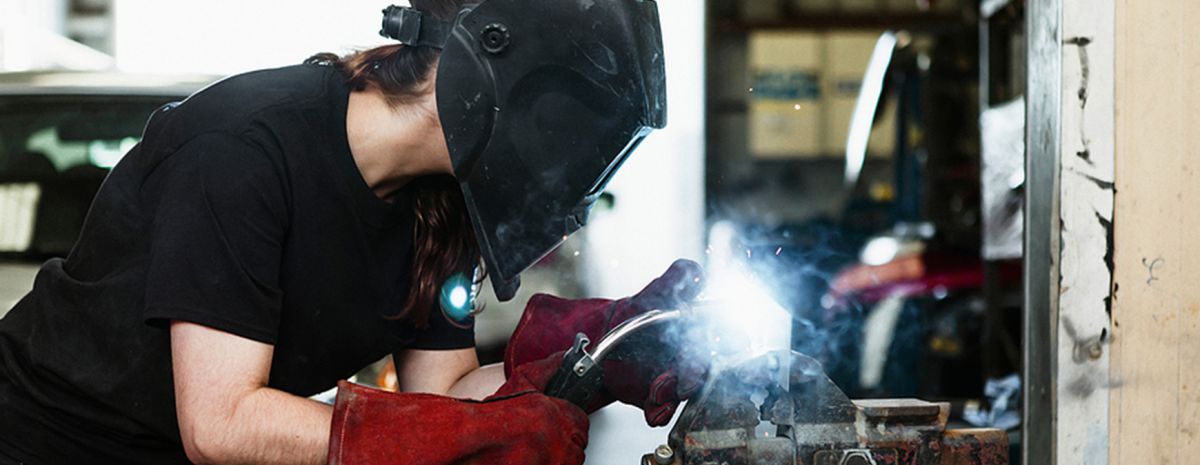TWS is a Great Training Option for Everyone
Learn more about how we can prepare you to advance your career.
It’s been nearly 60 years since the federal government passed laws making it illegal to discriminate against gender in the workplace, yet women in the United States are still lagging behind men in terms of income generation.1
When it comes to middle-skilled jobs—those requiring more than a high school diploma but less than a bachelor’s degree—women seem to be sticking to lower-paying positions, while men continually choose career paths leading to higher incomes.2
All the legal requirements to clear the way for women in both education and the workplace have been enacted, so what’s behind the lagging incomes?2
The Role of Tradition in Training and the Workforce
Women tend to sign up for vocational training programs leading to fields of middle-skilled employment that have traditionally been dominated by women, such as nursing and cosmetology, reports The Atlantic.2
Have You Considered a Career in the Skilled Trades?
Fill out the form to recieve a no obligation info packet.
In contrast, fewer women are signing up for welding classes or programs that train electricians, HVAC technicians, pipefitters and other roles traditionally filled by men. The article cites both gender stereotypes and the possibility of harassment in the workplace in male-dominated industries as reasons for this divide.2
The Consequences of the Gender Divide
Nursing has a better-than-average job outlook for the next decade. Most of the growth in nursing, however, is going to registered nurses and specialty nursing, which often requires at least a bachelor’s degree.3
Compare that to the statistics of these trade jobs: Electricians earn $27 per hour and have a projected growth rate of 8%. Welders make $20 per hour and have a projected growth rate of 3%, and pipefitters earn a median of $26 per hour, with a growth potential of 4%.4,5,6*
The Threat to the Economy
Institute for Women’s Policy Research indicates 55% of middle-skill workers are women, but 83% of them are in jobs that pay less than $30,000 per year.7 Women are bearing the brunt of the economic consequences of the divide in labor.8
A report from Georgetown University found that of those with a certificate, women earn a median income of $27,864, while their male counterparts are earning a median of over $44,000.8
The consequences, however, affect more than just the women themselves. According to The Atlantic article, the families they support are more likely to be stuck in poverty, and industries relying on middle-skilled labor are suffering from a shortage of qualified laborers.2
In other words, getting more women into fields that are traditionally dominated by men has the potential to positively affect individual families, as well as the economy as a whole.2
Closing the Gap
The Problem: Gender Stereotypes and Socialization
Mary Alice McCarthy, Director of the Center on Education and Skills at the New America Foundation, illuminates why closing this gap may be a matter of encouraging more women to enter fields traditionally dominated by men.2
She points out career counseling tends to channel students into stereotypical fields, and socialization is the biggest contributor to the gender divide in certificate programs. In other words, nothing tangible is holding women back. Instead, it’s our ideas about who should be filling certain jobs that’s steering both men and women toward their career choices.2
One Solution: Career Myth-Busting
One way to combat this image issue is to demonstrate to young women that many of these male-dominated jobs are not “dark, dirty, and dangerous.”2 Instead, they are technically demanding, highly-skilled professions.
The American Welding Society Foundation, for example, hosts an exhibit at state fairs demonstrating the welding profession so women can see exactly what they would be doing.9 Women can discover how accessible the tasks are regardless of one’s body type, as some fear they are too small or weak for the job.2
A Boost for Women: Skilled Trades Scholarships
To encourage women to join the skilled trades, several scholarship programs are available for technical, trade and vocational schools. For example, Tulsa Welding School offer a needs-based scholarship for eligible female students: The Women in the Trades Scholarship fund was established to support women advancing their talents to find success in trades.
Crossing the Divide to a Brighter Future

It is possible for women to find success in the skilled trades and other traditionally male- dominated fields. When more of them gain the confidence to pursue these careers while taking advantage of scholarship and other financial assistance programs, the entire economy stands to gain.
* Tulsa area annual mean wage is $46,390, Jacksonville area annual mean wage is $42,910 and Houston area annual mean wage is $51,260 for welders, cutters, solderers and brazers (514121) reported by BLS as of May 2020 http://data.bls.gov/oes. Average starting salary for Professional Welder is $35,863 for TWS Tulsa and $35,157 for Jacksonville for graduates
employed during the 12 month period of 7/1/19 – 6/30/20. Average starting salary for Welding Specialist is $39,216 for TWSTC graduates employed during the 12 month period of 7/1/19- 6/30/20. Average starting salary for Professional Welder with Pipefitting is $38,379 for TWS Jacksonville graduates employed during the 12 month period of 7/1/19-6/30/20. Average starting salary for Professional Welder with Pipefitting is $31,275 for TWS Tulsa graduates employed during the 12 month period of 7/1/19-6/30/20. Average starting salary for Welding Specialist with Pipefitting is $36,085 for TWSTC graduates employed during the 12 month period of 7/1/19-6/30/20.
1https://www.equalrights.org/issue/economic-workplace-equality/discrimination-at-work/
2https://www.theatlantic.com/education/archive/2018/01/why-are-women-still-choosing-the-lowest-paying-jobs/551414/
3https://www.bls.gov/ooh/healthcare/registered-nurses.htm#tab-6
4https://www.bls.gov/ooh/construction-and-extraction/electricians.htm
5https://www.bls.gov/ooh/production/welders-cutters-solderers-and-brazers.htm
6https://www.bls.gov/ooh/construction-and-extraction/plumbers-pipefitters-and-steamfitters.htm
7https://iwpr.org/wp-content/uploads/2020/12/Middle-skills_layout-FINAL.pdf
8https://1gyhoq479ufd3yna29x7ubjn-wpengine.netdna-ssl.com/wp-content/uploads/2014/11/Certificates.FullReport.061812.pdf
9https://www.careersinwelding.com/mobile-exhibit/






